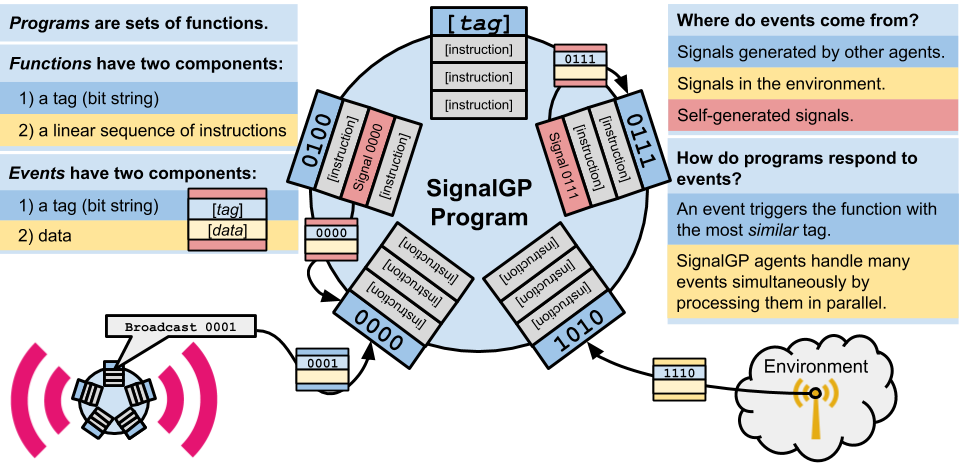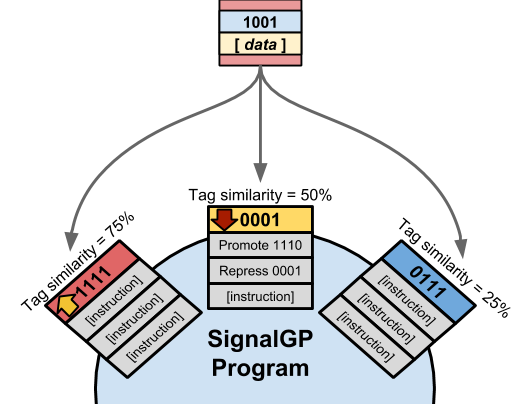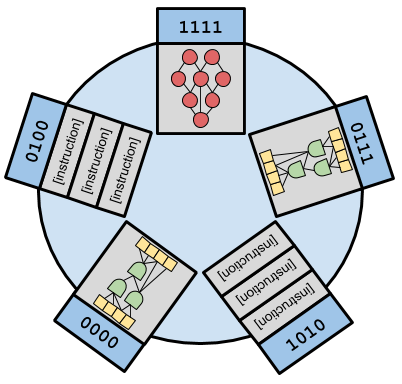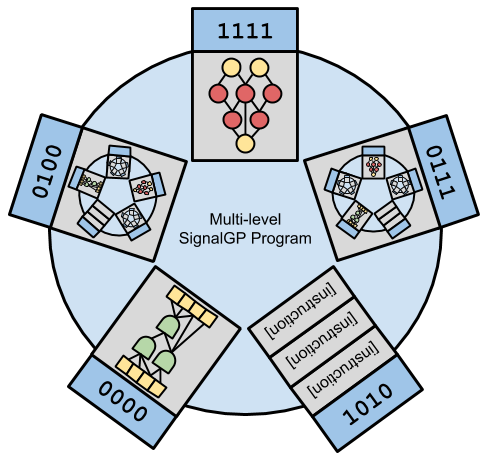Navigation
- Repository Overview
- About SignalGP
- Experiment Details
- Proposed Extensions to SignalGP
- GPTP Workshop Presentation
- Document References
Overview
This repository is associated with our 2018 Genetic Programming Theory and Practice (GPTP) workshop contribution, citation pending.
Spector et al. explored the use of tag-based naming for evolving modular programs in Chapter 1 of GPTP IX (Spector et al., 2011a). This contribution is a sort of follow up to Spector et al.’s 2011 chapter. We continue exploring tag-based referencing with SignalGP (Lalejini and Ofria, 2018). We investigate the importance of inexactness when making tag-based references: How important is imprecision when evolving programs that make use of evolvable names (i.e. tag-based referencing)? And, are there scenarios where requiring some precision is necessary when making tag-based references?
In addition to experimentally investigating the importance of inexactness when employing tag-based referencing, we discuss three major extensions to SignalGP that are facilitated by tag-based referencing: SignalGP function regulation, multi-representation SignalGP, and major transitions in individuality with SignalGP.
Contribution Authors
Abstract
Tags are evolvable labels that provide genetic programs a flexible mechanism for specification. Tags are used to label and refer to programmatic elements, such as functions or jump targets. However, tags differ from traditional, more rigid methods for handling labeling because they allow for inexact references; that is, a referring tag need not exactly match its referent. Here, we explore how adjusting the threshold for how what qualifies as a match affects adaptive evolution. Further, we propose broadened applications of tags in the context of a genetic programming (GP) technique called SignalGP. SignalGP gives evolution direct access to the event-driven paradigm. Program modules in SignalGP are tagged and can be triggered by signals (with matching tags) from the environment, from other agents, or due to internal regulation. Specifically, we propose to extend this tag based system to: (1) provide more fine-grained control over module execution and regulation (e.g., promotion and repression) akin to natural gene regulatory networks, (2) employ a mosaic of GP representations within a single program, and (3) facilitate major evolutionary transitions in individuality (i.e., allow hierarchical program organization to evolve de novo).
What is SignalGP?

SignalGP is a genetic programming technique designed to give evolution direct access to the event-driven programming paradigm. For full details on SignalGP, see (Lalejini and Ofria, 2018).
In this work and in prior work, we use SignalGP in the context of linear GP (LGP) where programs are linear sequences of instructions. SignalGP programs (in the context of LGP) are sets of functions where each function associates a tag with a linear sequence of instructions.
Instruction Set
The SignalGP instruction set we used for this work can be found here: instruction set documentation.
Experiment Details
Our experiments address the following questions:
- How important is imprecision when evolving programs that make use of evolvable names (i.e. tag-based referencing)?
- Spoiler: Allowing for some imprecision is crucial. Exact name matching does not perform well.
- And, are there scenarios where requiring some precision is necessary when making tag-based references?
- Spoiler: Yes, when genetic programs need the capacity to ignore references, requiring some minimum precision (tag-similarity) for tag-based references is important.
Source Code
The source code for all experiments performed in this contribution can be found in this repository: ./chg_env/source.
The compiling/running the experiments require the Empirical library.
SignalGP Program Solutions for Experiment Problems
Example SignalGP program solutions for the two test problems used for our experiments can be found here: example solutions.
Data Analyses
Our data can be found in this repository: ./data/
SignalGP Extensions
In addition to experimentally poking tag-based referencing, our paper discusses several extensions to SignalGP, each briefly discussed below.
Function regulation

SignalGP is easily extended to model gene regulatory networks where functions can be up-regulated (i.e. be made more likely to be referenced by a tag) or down-regulated (i.e. be made less likely to be referenced by a tag). We can associate a regulatory modifier with each function that adjusts the calculated similarity between the function’s tag and any referring tag (e.g. a call instruction or event tag). We can add regulatory instructions to the instruction set that increase or decrease function regulatory modifiers, using tag-based referencing to determine which function should be regulated by a particular instruction.
Function regulation provides yet another mechanism for phenotypic flexibility, allowing SignalGP programs to alter referential relationships in response to environmental feedback. Such a mechanism might be useful for problems that require within-lifetime learning or general behavioral plasticity.
Multi-representation SignalGP

SignalGP functions are, at their core, input-output machines. Thus far, we have arbitrarily chosen to stick linear GP inside of SignalGP functions; however, we could have used any representation capable of processing input and producing output (by generating signals or by manipulating memory). We could even employ multiple representations (e.g. ANNs, Markov network brains, handcoded modules, etc) within the same SignalGP program.
Major transitions in individuality with SignalGP

In a major evolutionary transition in individuality, formerly distinct individuals unite to form a new, more complex lifeform, redefining what it means to be an individual. The evolution of eukaryotes, multi-cellular life, and eusocial insect colonies are all examples of transitions in individuality.
We can take the multi-representation extension to SignalGP one step further. We can consider a single SignalGP program as an input-output machine in and of itself. Thus, we can imagine a ‘major transitions in individuality’ mutation operator that, when applied, adds a function to the mutated individual that contains a copy of another SignalGP agent in the population. This type of mutation operator would generate hierarchically organized SignalGP programs where programs may be composed of (homogeneous or heterogeneous) groups of SignalGP programs where each of these sub-programs may themselves be composed of many SignalGP programs, et cetera.
Workshop Presentation
My presentation from the 2018 GPTP workshop can be found here. Feel free to leave comments.
References
Lalejini, A., & Ofria, C. (2018). Evolving Event-driven Programs with SignalGP. In Proceedings of the Genetic and Evolutionary Computation Conference. ACM. https://doi.org/10.1145/3205455.3205523
Spector, L., Harringtion, K., Martin, B., & Helmuth, T. (2011a). What’s in an Evolved Name? The Evolution of Modularity via Tag-Based Reference. In R. Riolo, E. Vladislavleva, & J. H. Moore (Eds.), Genetic Programming Theory and Practice IX (pp. 1–16). New York, NY: Springer New York. https://doi.org/10.1007/978-1-4614-1770-5
Spector, L., Martin, B., Harrington, K., & Helmuth, T. (2011b). Tag-based modules in genetic programming. GECCO ’11: Proceedings of the 13th Annual Conference on Genetic and Evolutionary Computation, 1419–1426. https://doi.org/doi:10.1145/2001576.2001767